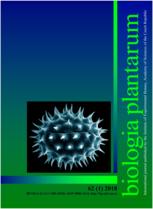Ver ítem
- xmlui.general.dspace_homeCentros Regionales y EEAsCentro Regional Buenos Aires NorteEEA San PedroArtículos científicosxmlui.ArtifactBrowser.ItemViewer.trail
- Inicio
- Centros Regionales y EEAs
- Centro Regional Buenos Aires Norte
- EEA San Pedro
- Artículos científicos
- Ver ítem
Overexpression of glycine-rich RNA-binding protein in tomato renders fruits with higher protein content after cold storage
Resumen
Glycine-rich RNA-binding proteins (GR-RBPs) are involved in RNA processing and also some of them are output signals of the circadian clock. In tomato, one GR-RBP gene family (LeGRP1) is composed by three highly homologous genes (LeGRP1a-c); each one rendering three transcriptional products: the un-spliced pre-RNA (preLegrp1a-c), the mature mRNA (mLegrp1a-c) and the alternatively spliced mRNA (asLegrp1a-c). To get insight into their regulation and impact
[ver mas...]
Glycine-rich RNA-binding proteins (GR-RBPs) are involved in RNA processing and also some of them are output signals of the circadian clock. In tomato, one GR-RBP gene family (LeGRP1) is composed by three highly homologous genes (LeGRP1a-c); each one rendering three transcriptional products: the un-spliced pre-RNA (preLegrp1a-c), the mature mRNA (mLegrp1a-c) and the alternatively spliced mRNA (asLegrp1a-c). To get insight into their regulation and impact on RNA metabolism in fruits, Solanum lycopersicum cv. Micro-Tom was transformed with preLeGRP1a fused to the polygalacturonase promoter, which drives expression to fruits from the mature green stage. Our results demonstrated a complex positive regulation of LeGRPs, in which LeGRP1a overexpression led to the induction of the others LeGRP1 members. Even though the LeGRP1 transcription and the content of three LeGRPs proteins were affected, the overall LeGRP protein circadian rhythm profile was similar in transgenic and WT fruits. However, when the fruits are kept at chilling temperature after harvest, total protein content was significantly higher in transgenic than in WT fruits, and the content of some free amino acids was modified. The results obtained suggest a probable role of LeGRP1s: structural rearrangements and/or stabilization of mRNA to allow efficient processing of fruits under cold conditions.
[Cerrar]

Autor
Ruggieri, Germán;
Triassi, Agustina;
Alvarez, Clarisa E.;
Gola, Aldana;
Wiggenhauser, Julieta;
Budde, Claudio Olaf;
Lara, María Valeria;
Müller, Gabriela Leticia;
Fuente
Biologia Plantarum 62 (3) : 501-510 (2018)
Fecha
2018
ISSN
1573-8264
0006-3134
0006-3134
Formato
pdf
Tipo de documento
artículo
Palabras Claves
Derechos de acceso
Embargado
 Excepto donde se diga explicitamente, este item se publica bajo la siguiente descripción: Creative Commons Attribution-NonCommercial-ShareAlike 2.5 Unported (CC BY-NC-SA 2.5)
Excepto donde se diga explicitamente, este item se publica bajo la siguiente descripción: Creative Commons Attribution-NonCommercial-ShareAlike 2.5 Unported (CC BY-NC-SA 2.5)

